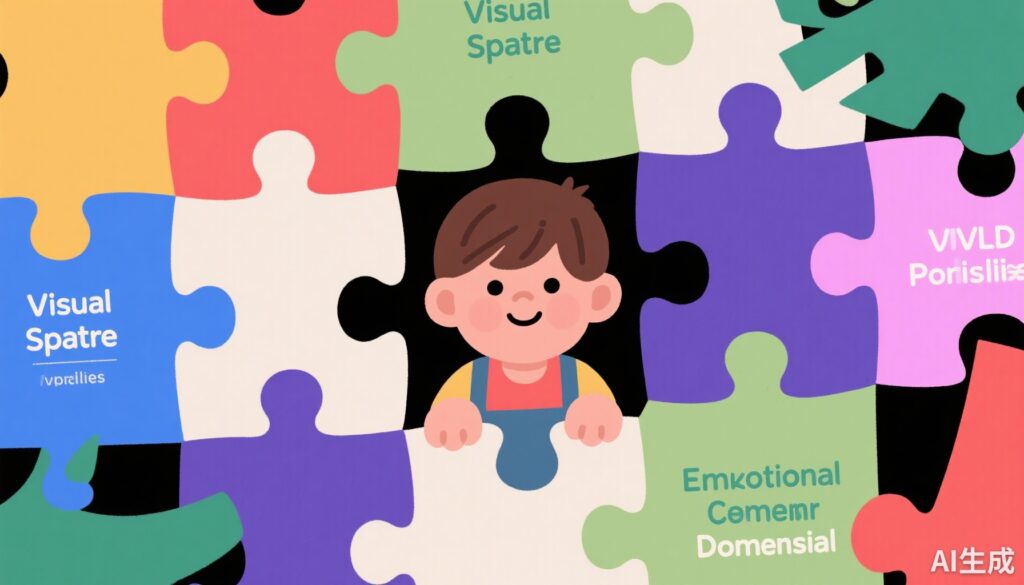ハイライト
- 非言語学習障害(NVLD)は、視覚空間処理、推論、および変動的な精神科併存症を特徴とする4つの異なるプロファイルで表される臨床的異質性を示します。
- 3つのプロファイルでは、視覚空間または流動的推論能力のいずれかまたは両方の障害が見られ、学業成績の低下や特定の精神疾患(不安や注意障害)と関連しています。
- 1つのプロファイルでは視覚空間の欠損が見られず、機能障害がない低い言語知能が見られました。これは、既存のNVLD診断基準の見直しの必要性を示唆しています。
研究背景と疾患負担
非言語学習障害(NVLD)は、1960年代に初めて記述された神経発達障害であり、視覚空間処理、社会的スキル、運動機能の困難を特徴とします。長年にわたり認識されてきましたが、正確な臨床像は議論の余地があり、診断と治療戦略が複雑になっています。症状の表現の変動性と他の神経発達障害や精神疾患との重複が診断の課題を増加させています。NVLDのある小児は、数学、読解、社会的コミュニケーションなどで学業上の困難を経験することが多く、著しい機能的障害と心理社会的負担につながります。異なる現象型プロファイルを理解することで、診断の精度を向上させ、対象別の介入を促進し、研究の厳密性を高めることができます。
研究デザイン
この研究では、ニューヨーク市で5歳から21歳の子どもと青少年の脳発達とメンタルヘルスを評価する大規模コミュニティベースのコホートであるHealthy Brain Network(HBN)リリース8(2017-2021年)のデータを使用し、横断的デザインを採用しました。参加者は研究参加への興味や臨床的な懸念に基づいて募集され、行動、感情、学習の困難を豊かにするサンプルが得られました。研究では、包括的な認知、学術、精神疾患データを持つ1,640人の参加者から、研究定義のNVLDの基準を満たす180人の子どもが特定されました。
無監督クラスタリングアルゴリズムであるLouvainコミュニティ検出を使用して、視覚空間指標(Wechsler Visual-Spatial Index [VSI])、流動的推論能力(Fluid Reasoning Index [FRI])、学業成績、精神症状を含む診断パラメータのパターンに基づいて参加者をグループ化することで、NVLDの異質性を解析しました。機能的障害と精神疾患診断との関連性も評価されました。分析は2021年4月から9月にかけて行われました。
主要な結果
この研究では、4つの異なるNVLDプロファイルが特定されました。
1. プロファイル1(44人の子ども):視覚空間(VSI平均 96.11)と流動的推論(FRI平均 77.18)の両方の欠損を特徴とし、最も高い不注意と攻撃性のレベルを示し、最も低い読解力のスコアを示しました。これらの子どもは、著しい学業的および行動的障害を示しました。
2. プロファイル2(37人の子ども):視覚空間処理(平均 VSI 78.27)の欠損のみを示し、流動的推論は比較的保たれていました。このグループは、最も高い数学のスコアと不安障害の頻度の増加(オッズ比 2.19)を示し、特定の学習障害の頻度が最も低かったため、異なる認知・精神科プロファイルを示していました。
3. プロファイル3(35人の子ども):流動的推論の欠損(平均 FRI 88.6)を示し、視覚空間機能は保たれていました。特に、このグループは最も高い読解力のスコアを達成しており、NVLD現象型間の学業成果の異質性を示しています。
4. プロファイル4:他のプロファイルとは異なり、視覚空間または流動的推論の指数に欠損が見られず、最も低い言語知能(平均 87.12)を示し、有意な機能的障害や精神科併存症が見られませんでした。これは、これらの子どもが伝統的なNVLD基準を満たさない可能性があることを示唆し、診断の複雑さを強調しています。
相関分析では、視覚空間または流動的推論のスコアとプロファイル1-3の機能的学業成果との間に正の相関が見られ、これらの認知次元の臨床的重要性が確認されました。例えば、プロファイル2では、流動的推論が数学の成績と正の相関を示しました(r=0.33, P<0.001)。
専門家コメント
この厳密な現象型の区別は、大規模な臨床的に豊富な人口を活用することで、NVLD診断の長期的な異質性に対処しています。異なる認知と精神科プロファイルを持つ離散サブグループの識別は、従来の単一的なNVLD構造を超えて理解を進展させます。特に、視覚空間の欠損がなく、機能的障害のない言語知能の低下を示すプロファイルの存在は、NVLD診断基準の再考を促し、他の発達障害との重複についての疑問を提起します。
臨床的意義には、神経認知プロファイルに基づく差別診断が必要であることが含まれます。これにより、介入を効果的にカスタマイズすることができます。例えば、プロファイル1では、注意と攻撃性の管理が優先されるべきであり、プロファイル2では不安のモニタリングが不可欠です。さらに、各プロファイル内の強みと弱点に応じて、学業支援が細分化されるべきです。
制限点には、横断的デザインによる因果関係の推論の不可能性と、コミュニティベースの募集による臨床人口への一般化の限界が含まれます。さらなる縦断的研究が必要です。
結論
この研究は、非言語学習障害内の異質性を強調し、影響を受けた子どもたちの中で4つの異なる認知と精神科プロファイルを特定しました。3つのプロファイルは、学業と精神科の課題に関連する視覚空間の欠損を含む古典的なNVLDの特性と一致します。4番目のプロファイルは、伝統的なNVLD基準に挑戦し、過剰な包含性や誤分類の可能性を示唆しています。これらの洞察は、精緻な診断フレームワーク、改善された個別化された介入、最適な結果を達成するために焦点を当てた研究努力の道を開きます。
参考文献
Margolis AE, DeRosa J, Kang M, Fisher PW, Thomas L, Southwick C, Broitman J, Davis JM, Nikolaidis A, Milham MP. Nonverbal Learning Disability, Academic Skills, and Psychiatric Diagnoses in Children. JAMA Netw Open. 2025 Oct 1;8(10):e2533848. doi: 10.1001/jamanetworkopen.2025.33848. PMID: 41032301.
追加の関連文献:
– Semrud-Clikeman M. Nonverbal learning disorders: A critical review. J Clin Exp Neuropsychol. 2000;22(4):518-536.
– Rourke BP. Syndrome of nonverbal learning disabilities: Neurodevelopmental manifestations. Guilford Press; 1989.
– Ladega-Bland C, Hale JB. Neurodevelopmental disorders and learning disabilities: Historical perspectives and current models. Child Adolesc Psychiatr Clin N Am. 2020;29(1):1-14.



